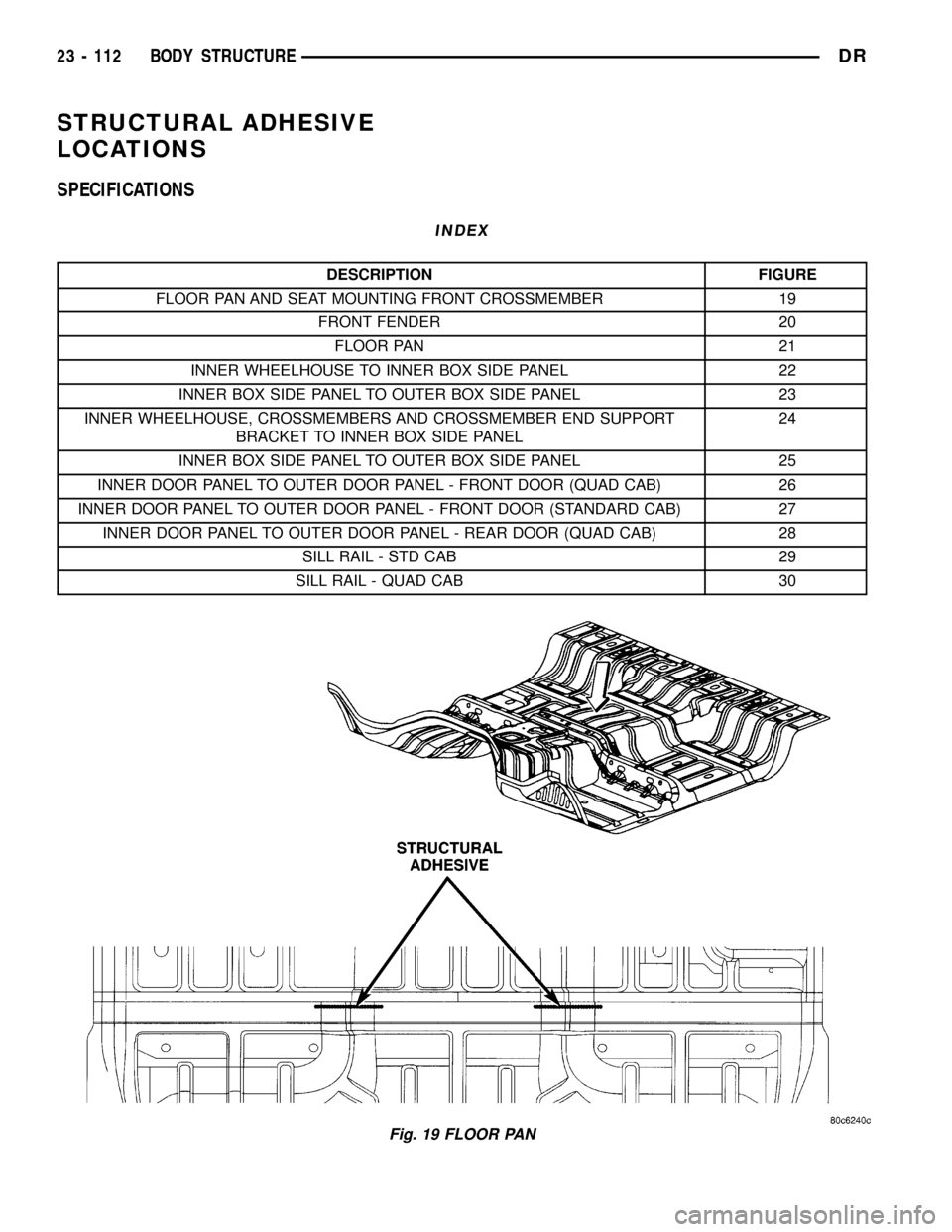1998 DODGE RAM 1500 Index
[x] Cancel search: IndexPage 2390 of 2627

BODY STRUCTURE
TABLE OF CONTENTS
page page
GAP AND FLUSH
SPECIFICATIONS.......................95
OPENING DIMENSIONS
SPECIFICATIONS - BODY OPENING
DIMENSIONS.........................99
SEALER LOCATIONS
SPECIFICATIONS......................102STRUCTURAL ADHESIVE LOCATIONS
SPECIFICATIONS......................112
WELD LOCATIONS
SPECIFICATIONS......................120
GAP AND FLUSH
SPECIFICATIONS
GAP & FLUSH DIMENSIONS INDEX
DESCRIPTION FIGURE
STANDARD CAB 1
QUAD CAB 2
PICKUP BOX 3
DRBODY STRUCTURE 23 - 95
Page 2394 of 2627

OPENING DIMENSIONS
SPECIFICATIONS - BODY OPENING
DIMENSIONS
INDEX
DESCRIPTION FIGURE
WINDSHIELD OPENING 4
DOOR OPENING - STANDARD
CAB5
DOOR OPENINGS - QUAD CAB 6
REAR WINDOW OPENING 7
ENGINE COMPARTMENT/FRONT
STRUCTURE8
Fig. 4 WINDSHIELD OPENING
DRBODY STRUCTURE 23 - 99
Page 2397 of 2627

SEALER LOCATIONS
SPECIFICATIONS
INDEX
DESCRIPTION FIGURE
LOWER WINDSHIELD PILLAR, LOWER PLENUM AND COWL BAR 9
DASH PANEL, LOWER PLENUM AND COWL SIDE PANEL 10
LOWER DASH PANEL, LOWER COWL SIDE AND FLOOR PAN SUPPORT 11
ROOF PANEL, OUTER BODY SIDE APERTURE AND BACKLITE 12
CAB BACK, BODY SIDE APERTURE - REAR AND BACKLITE LOWER CORNER 13
LOWER DASH PANEL AND FLOOR PAN 14
FLOOR PAN AND BODY SIDE APERTURE 15
FRONT FLOOR PAN AND REAR PAN 16
FLOOR PAN TO CAB BACK 17
PICKUP BOX 18
Fig. 9 LOWER WINDSHIELD PILLAR
23 - 102 BODY STRUCTUREDR
Page 2407 of 2627

STRUCTURAL ADHESIVE
LOCATIONS
SPECIFICATIONS
INDEX
DESCRIPTION FIGURE
FLOOR PAN AND SEAT MOUNTING FRONT CROSSMEMBER 19
FRONT FENDER 20
FLOOR PAN 21
INNER WHEELHOUSE TO INNER BOX SIDE PANEL 22
INNER BOX SIDE PANEL TO OUTER BOX SIDE PANEL 23
INNER WHEELHOUSE, CROSSMEMBERS AND CROSSMEMBER END SUPPORT
BRACKET TO INNER BOX SIDE PANEL24
INNER BOX SIDE PANEL TO OUTER BOX SIDE PANEL 25
INNER DOOR PANEL TO OUTER DOOR PANEL - FRONT DOOR (QUAD CAB) 26
INNER DOOR PANEL TO OUTER DOOR PANEL - FRONT DOOR (STANDARD CAB) 27
INNER DOOR PANEL TO OUTER DOOR PANEL - REAR DOOR (QUAD CAB) 28
SILL RAIL - STD CAB 29
SILL RAIL - QUAD CAB 30
Fig. 19 FLOOR PAN
23 - 112 BODY STRUCTUREDR
Page 2415 of 2627

WELD LOCATIONS
SPECIFICATIONS
INDEX
DESCRIPTION FIGURE
FENDER BRACE, CLOSURE TUBE AND FRAME MOUNTING BRACKET TO FRONT
FENDER SUPPORT, FRONT FENDER AND RADIATOR TUBE31
STEERING COLUMN SUPPORT, CONNECTOR WIRING BRACKET AND WELD NUTS
TO LOWER PLENUM PANEL32
WIPER ATTACHING WELD NUTS AND VACUUM RESERVOIR ATTACHING STUDS TO
COWL PAR PANEL33
DASH PANEL TO FRONT FLOOR PAN 34
DASH PANEL TO LOWER PLENUM PANEL 35
LOWER PLENUM PANEL TO COWL BACK PANEL 36
FRONT FENDER AND RADIATOR TUBE DASH PANEL, INSTRUMENT PANEL
MOUNTING BRACKET, AND WELD NUTS TO COWL SIDE PANEL - LEFT SIDE37
DASH PANEL, LOWER PLENUM PANEL AND COWL PANEL BAR TO COWL SIDE
PANEL - LEFT SIDE38
FRONT FENDER AND RADIATOR TUBE DASH PANEL, INSTRUMENT PANEL
MOUNTING BRACKET AND WELD NUTS TO COWL SIDE PANEL - RIGHT SIDE39
DASH PANEL, LOWER PLENUM PANEL AND COWL PANEL BAR TO COWL SIDE
PANEL - RIGHT SIDE40
REINFORCEMENT AND HEADLAMP MOUNTING PANEL TO OUTER FENDER PANEL 41
SEAT MOUNTING FRONT BRACKETS TO SEAT MOUNTING FRONT CROSSMEMBER
TO FRONT FLOOR PAN42
AIR BAG MODULE BRACKET SHIFTER MOUNTING PLATE AND REAR FLOOR PANE
TO FRONT FLOOR PAN43
RIGHT TO LEFT REAR FLOOR CROSSMEMBER AND RIGHT TO LEFT SEAT
MOUNTING CROSSMEMBER44
REAR FLOOR CROSSMEMBER, SEAT MOUNTING CROSSMEMBER AND
UNDERBODY SUPPORT TO FLOOR SILL45
SEAT MOUNTING FRONT CROSSMEMBER TO FRONT FLOOR PAN TO UNDERBODY
SUPPORT46
FRONT SEAT MOUNTING CROSSMEMBERS TO FRONT SEAT MOUNTING BRACKET
TO FRONT FLOOR PAN47
REAR FLOOR CROSSMEMBERS TO REAR FLOOR PAN 48
FLOOR SILL TO FRONT SEAT MOUNTING CROSSMEMBER, FRONT AND REAR
FLOOR PAN49
AIR BAG MODULE BRACKET, SHIFTER MOUNTING PLATE AND FRONT SEAT
MOUNTING CROSSMEMBER TO FRONT FLOOR PAN50
REAR SEAT MIDDLE MOUNTING PLATE TO REAR FLOOR PAN TO FRONT FLOOR
PA N51
REAR FLOOR CROSSMEMBER, SEAT MOUNTING CROSSMEMBER AND
UNDERBODY SUPPORT TO FLOOR SILL52
LEFT REAR CROSSMEMBER TO RIGHT REAR CROSSMEMBER TO REAR FLOOR
PA N53
23 - 120 BODY STRUCTUREDR
Page 2504 of 2627

(4) Reconnect the battery negative cable.
BLEND DOOR ACTUATOR
DESCRIPTION
The blend door actuators are reversible, 12-volt
Direct Current (DC), servo motors. Models with the
single zone heater and air conditioner system have a
single blend door, which is controlled by a single
blend door actuator. Models with the optional dual
zone front heater and air conditioner system have
dual blend doors, which are controlled by two blend
door actuators. The single zone blend door actuator is
located on the driver side end of the HVAC housing,
close to the dash panel. In the dual zone system, the
same blend door actuator used for the single zone
system becomes the driver side blend door actuator,
and is mechanically connected to only the driver side
blend door. In the dual zone system, a second sepa-
rate blend door actuator is also located on the top of
the HVAC housing and is mechanically connected to
only the passenger side blend door.
The blend door actuators are interchangeable with
each other, as well as with the actuators for the
mode door, defrost door and the recirculation door.
Each actuator is contained within an identical blackmolded plastic housing with an integral wire connec-
tor receptacle. Integral mounting tabs allow the
actuator to be secured with three screws to the
HVAC housing. Each actuator also has an identical
output shaft with splines that connects it to the link-
age that drives the proper door. The blend door
actuators do not require mechanical indexing to the
blend door linkage, as they are electronically cali-
brated by the heater-A/C control module. The blend
door actuators cannot be adjusted or repaired and, if
damaged or faulty, they must be replaced.
OPERATION
Each blend door actuator is connected to the A/C-
heater control through the vehicle electrical system by a
dedicated two-wire lead and connector from the HVAC
wire harness. The blend door actuator can move the
blend-air door in two directions. When the A/C-heater
control pulls the voltage on one side of the motor con-
nection high and the other connection low, the blend-air
door will move in one direction. When the A/C-heater
control reverses the polarity of the voltage to the motor,
the blend-air door moves in the opposite direction.
When the A/C-heater control makes the voltage to both
connections high or both connections low, the blend-air
door stops and will not move. The motor connections
also provide a feedback signal to the A/C-heater control.
This feedback signal allows the A/C-heater control to
monitor the operation and relative positions of the blend
door actuator and the blend-air door. The A/C-heater
control learns the blend door stop positions during the
calibration procedure and will store a diagnostic trouble
code (DTC) for any problems it detects in the blend door
actuator circuits.
The blend door actuator can be diagnosed using a
DRBIIItscan tool. Refer to Body Diagnostic Proce-
dures for more information. The blend door actuators
cannot be adjusted or repaired and, if damaged or
faulty, they must be replaced.
REMOVAL
WARNING: ON VEHICLES EQUIPPED WITH AIR-
BAGS, DISABLE THE AIRBAG SYSTEM BEFORE
ATTEMPTING ANY STEERING WHEEL, STEERING
COLUMN, OR INSTRUMENT PANEL COMPONENT
DIAGNOSIS OR SERVICE. DISCONNECT AND ISO-
LATE THE BATTERY NEGATIVE (GROUND) CABLE,
THEN WAIT TWO MINUTES FOR THE AIRBAG SYS-
TEM CAPACITOR TO DISCHARGE BEFORE PER-
FORMING FURTHER DIAGNOSIS OR SERVICE. THIS
IS THE ONLY SURE WAY TO DISABLE THE AIRBAG
SYSTEM. FAILURE TO TAKE THE PROPER PRE-
CAUTIONS COULD RESULT IN ACCIDENTAL AIR-
BAG DEPLOYMENT AND POSSIBLE PERSONAL
INJURY.
Fig. 15 A/C Pressure Transducer - 3.7L Shown
1 - NUT
2 - FRONT UPPER CROSSMEMBER
3 - A/C CONDENSER
4 - NUT (2)
5 - SUCTION LINE
6 - A/C COMPRESSOR
7 - A/C PRESSURE TRANSDUCER
8 - WIRE HARNESS CONNECTOR
9 - A/C DISCHARGE LINE
DRCONTROLS 24 - 17
A/C PRESSURE TRANSDUCER (Continued)
Page 2508 of 2627

cal indexing to the defrost door, as it is electronically
calibrated by the heater-A/C control module. The
defrost door actuator cannot be adjusted or repaired
and, if damaged or faulty, it must be replaced.
OPERATION
The defrost door actuator is connected to the heat-
er-A/C control module through the vehicle electrical
system by a dedicated two-wire lead and connector
from the HVAC wire harness. The defrost door actua-
tor can move the defrost door in two directions.
When the heater-A/C control module pulls the volt-
age on one side of the motor connection high and the
other connection low, the defrost door will move in
one direction. When the module reverses the polarity
of the voltage to the motor, the defrost door moves in
the opposite direction. When the module makes the
voltage to both connections high or both connections
low, the defrost door stops and will not move. These
same motor connections also provide a feedback sig-
nal to the heater-A/C control module. This feedback
signal allows the module to monitor the operation
and relative positions of the defrost door actuator
and the defrost door. The heater-A/C control module
learns the defrost door stop positions during the cal-
ibration procedure and will store a Diagnostic Trou-
ble Code (DTC) for any problems it detects in the
defrost door actuator circuits. The defrost door actua-
tor can be diagnosed using a DRBIIItscan tool.
Refer to Body Diagnostic Procedures.
REMOVAL
WARNING: ON VEHICLES EQUIPPED WITH AIR-
BAGS, DISABLE THE AIRBAG SYSTEM BEFORE
ATTEMPTING ANY STEERING WHEEL, STEERING
COLUMN, OR INSTRUMENT PANEL COMPONENT
DIAGNOSIS OR SERVICE. DISCONNECT AND ISO-
LATE THE BATTERY NEGATIVE (GROUND) CABLE,
THEN WAIT TWO MINUTES FOR THE AIRBAG SYS-
TEM CAPACITOR TO DISCHARGE BEFORE PER-
FORMING FURTHER DIAGNOSIS OR SERVICE. THIS
IS THE ONLY SURE WAY TO DISABLE THE AIRBAG
SYSTEM. FAILURE TO TAKE THE PROPER PRE-
CAUTIONS COULD RESULT IN AN ACCIDENTAL
AIRBAG DEPLOYMENT AND POSSIBLE PERSONAL
INJURY.
(1) Disconnect and isolate the battery negative
cable.
(2) Remove the instrument panel from the vehicle
(Refer to 23 - BODY/INSTRUMENT PANEL/IN-
STRUMENT PANEL ASSEMBLY - REMOVAL).
(3) Disconnect the wire harness connector from the
defrost door actuator (Fig. 19).
(4) Remove the screws that secure the defrost door
actuator to the HVAC housing.(5) Remove the defrost door actuator from the
HVAC housing.
INSTALLATION
(1) Position the defrost door actuator into the
HVAC housing. If necessary, rotate the actuator
slightly to align the splines on the actuator output
sleeve with those on the defrost door linkage.
(2) Install and tighten the screws that secure the
defrost door actuator to the HVAC housing. Tighten
the screws to 2 N´m (17 in. lbs.).
(3) Connect the HVAC wire harness connector to
the defrost door actuator.
(4) Install the instrument panel (Refer to 23 -
BODY/INSTRUMENT PANEL/INSTRUMENT
PANEL ASSEMBLY - INSTALLATION).
(5) Reconnect the battery negative cable.
Fig. 19 HVAC Housing - Dual Zone Shown, Single
Zone Typical
1 - NUT
2 - PASSENGER BLEND DOOR ACTUATOR
3 - NUT
4 - INLET BAFFLE
5 - RECIRCULATION DOOR ACTUATOR
6 - RECIRCULATION DOOR
7 - DRIVER SIDE BLEND DOOR ACTUATOR
8 - HVAC HOUSING
9 - BOLT
10 - DEFROSTER DOOR ACTUATOR
11 - MODE DOOR ACTUATOR
DRCONTROLS 24 - 21
DEFROST DOOR ACTUATOR (Continued)
Page 2510 of 2627

(2) Assemble the HVAC housing (Refer to 24 -
HEATING & AIR CONDITIONING/DISTRIBUTION/
HVAC HOUSING - ASSEMBLY).
(3) Connect the HVAC wire harness connector to
the evaporator temperature sensor.
(4) Install the HVAC housing (Refer to 24 - HEAT-
ING & AIR CONDITIONING/DISTRIBUTION/HVAC
HOUSING - INSTALLATION).
(5) Reconnect the battery negative cable.
MODE DOOR ACTUATOR
DESCRIPTION
The mode door actuator is a reversible 12-volt
Direct Current (DC) servo motor. The mode door
actuator is located on the HVAC housing, behind the
instrument panel and is mechanically connected to
the mode door.
The mode door actuator is interchangeable with
the actuators for the blend door(s), defrost door and
the recirculation door. Each actuator is contained
within an identical black molded plastic housing with
an integral wire connector receptacle. Integral
mounting tabs allow the actuator to be secured with
three screws to the HVAC housing. Each actuator
also has an identical output shaft with splines that
connects it to the linkage that drives the proper door.
The mode door actuator does not require mechanical
indexing to the mode door linkage, as it is electroni-
cally calibrated by the heater-A/C control module.
The mode door actuator cannot be adjusted or
repaired and, if damaged or faulty, it must be
replaced.
OPERATION
The mode door actuator is connected to the A/C-
heater control through the vehicle electrical system
by a dedicated two-wire lead and connector from the
HVAC wire harness. The mode door actuator can
move the mode door in two directions. When the A/C-
heater control pulls the voltage on one side of the
motor connection high and the other connection low,
the mode door will move in one direction. When the
A/C-heater control reverses the polarity of the volt-
age to the motor, the mode door moves in the oppo-
site direction. When the A/C-heater control makes
the voltage to both connections high or both connec-
tions low, the mode door stops and will not move.
These same motor connections also provide a feed-
back signal to the A/C-heater control. This feedback
signal allows the A/C-heater control to monitor the
operation and relative position of the mode door
actuator and the mode door. The A/C-heater control
learns the mode door stop positions during the cali-
bration procedure and will store a diagnostic troublecode (DTC) for any problems it detects in the mode
door actuator circuits.
The mode door actuator can be diagnosed using a
DRBIIItscan tool. Refer to Body Diagnostic Proce-
dures for more information. The mode door actuator
cannot be adjusted or repaired and, if damaged or
faulty, it must be replaced.
REMOVAL
WARNING: ON VEHICLES EQUIPPED WITH AIR-
BAGS, DISABLE THE AIRBAG SYSTEM BEFORE
ATTEMPTING ANY STEERING WHEEL, STEERING
COLUMN, OR INSTRUMENT PANEL COMPONENT
DIAGNOSIS OR SERVICE. DISCONNECT AND ISO-
LATE THE BATTERY NEGATIVE (GROUND) CABLE,
THEN WAIT TWO MINUTES FOR THE AIRBAG SYS-
TEM CAPACITOR TO DISCHARGE BEFORE PER-
FORMING FURTHER DIAGNOSIS OR SERVICE. THIS
IS THE ONLY SURE WAY TO DISABLE THE AIRBAG
SYSTEM. FAILURE TO TAKE THE PROPER PRE-
CAUTIONS COULD RESULT IN ACCIDENTAL AIR-
BAG DEPLOYMENT AND POSSIBLE PERSONAL
INJURY.
(1) Disconnect and isolate the battery negative
cable.
(2) Remove the instrument panel from the vehicle
(Refer to 23 - BODY/INSTRUMENT PANEL/IN-
STRUMENT PANEL ASSEMBLY - REMOVAL).
(3) Disconnect the wire harness connector from the
mode door actuator (Fig. 22).
(4) Remove the screws that secure the mode door
actuator to the HVAC housing.
(5) Remove the mode door actuator from the HVAC
housing.
INSTALLATION
(1) Position the mode door actuator onto the HVAC
housing. If necessary, rotate the actuator slightly to
align the splines on the actuator output sleeve with
those on the mode door linkage.
(2) Install and tighten the screws that secure the
mode door actuator to the HVAC housing. Tighten
the screws to 2 N´m (17 in. lbs.).
(3) Connect the HVAC wire harness connector to
the mode door actuator.
(4) Install the instrument panel (Refer to 23 -
BODY/INSTRUMENT PANEL/INSTRUMENT
PANEL ASSEMBLY - INSTALLATION).
(5) Reconnect the battery negative cable.
DRCONTROLS 24 - 23
EVAPORATOR TEMPERATURE SENSOR (Continued)